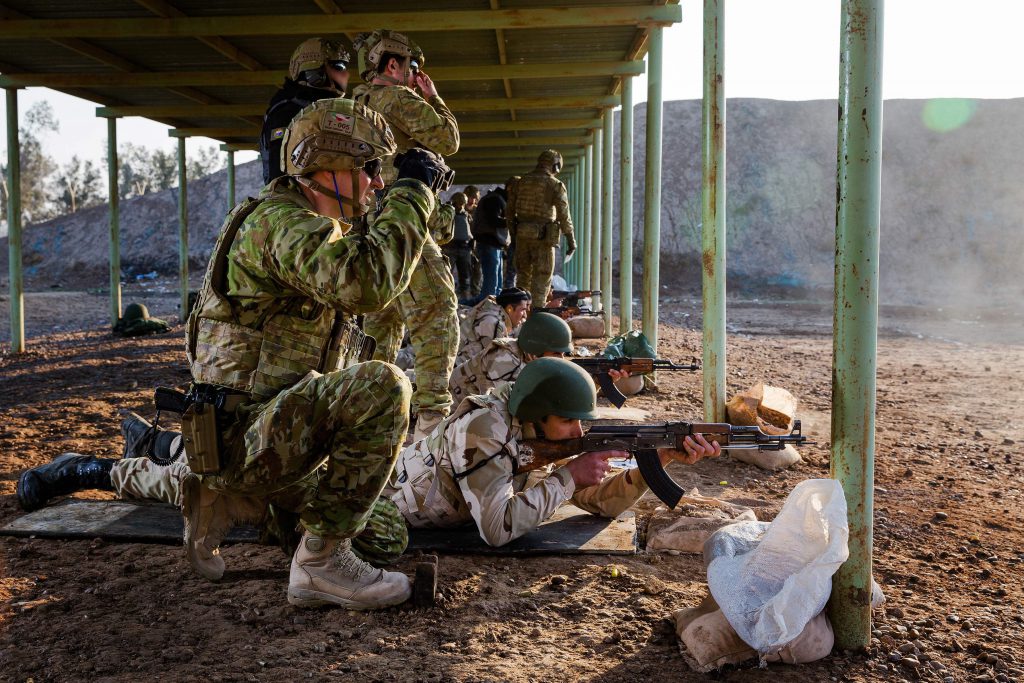
As it prepares to enter the sprawling ancient quarter of Mosul, the Iraqi Army has shaken off the claims that it’s not willing to fight.
The special-forces units leading the attack on the west of the city have pressed on despite heavy casualties, says the chief of the ADF’s Joint Operations Command, Vice Admiral David Johnston. Many of them trained by Australian Army instructors, the Iraqis have faced fierce, merciless combat in the approaches to the city. In the early stage of the operation, the spearhead Counter Terrorism Service, suffered significant casualties as the terror group hit them with waves of suicide bombers in vehicles packed with explosives.
‘CTS, has however proven to be adaptive,’ Johnston says. ‘There’s been a notable reduction in the number of Vehicle Borne Improvised Explosive Device attacks as the Iraqi forces improve their battlefield techniques.’ That has reduced casualties.
RAAF Hornet strike aircraft use precision weapons to deeply crater roads used by the suicide bombers and hit the bomb makers’ factories. They have also hit barges used by Daesh to move its fighters across the river. In the narrow streets and alleys that make up the oldest part of Iraq’s second largest city, the Iraqi troops will confront snipers and large numbers of improvised bombs placed by 3,000 to 5,000 fighters from the Islamic State terror group, known locally as Daesh. They are supported by coalition air strikes, many called in by Australian special-forces and often carried out by seven RAAF Hornets.
Fighting will be close and ferocious, Johnston says, and with an estimated 750,000 civilians still in West Mosul, the advance must be measured and deliberate. Since the operation began in October, the eastern part of the city, up to the Tigris River, has been largely secured. The strategically important junction point city has been captured, held and lost again many times over countless centuries by such notables as Saladin, Suleyman the Magnificent and Alexander the Great. West Mosul contains the “Old City” with narrower streets and denser urban terrain. That restricts the Iraqi troops’ freedom of manouevre and ability to use their military advantages as they are forced into narrow channels making them more vulnerable. Many alleyways are narrow enough for Daesh to stretch tarpaulins over them to block aerial surveillance. It fights from strongholds inter-connected with tunnels.
The twin focus of Australian special-forces is to help the Iraqis call in air strikes and to provide emergency medical care to wounded troops evacuated from the front lines. The Joint Terminal Air Controllers (JTACs), and the medical teams from Australia’s 80-strong Special Operations Task Group operate within secure coalition bases about 50km from the front lines. Using vision from manned and unmanned surveillance aircraft, the JTACs have called in 453 air strikes since the start of the offensive and that has been critical for CTS momentum, Johnston says. ‘The triage support provided by our SF medics in the Forward Operating Bases has provided vital life-saving medical stabilization and saved CTS lives,’ he adds.
While the priority is Mosul, Iraqi forces are also fighting Daesh in the Euphrates River valley, out towards the Syrian border, in Ninewah Province and around Bayji while dealing with ongoing security issues in Baghdad. There are Daesh fighters in isolated pockets throughout Iraq. ‘Immediately to the West of Mosul there is a force in Tal Afar, there are small groups in the Euphrates River Valley near the Syrian border, as well as in several provinces in and around Bayji and Kirkuk,’ Johnston observes. As the pressure on Daesh increases, it’s expected to step up attacks on civilians throughout Iraq to draw security forces away from Mosul.
The pace of clearing the eastern part of the city has been determined by the need to protect the civilian population. While civilians living in the city of Ramadi had largely fled or been driven out by Daesh, many of those in Mosul have stayed there. The Iraqi forces are advancing from several directions to divide the defenders and stretch them more thinly. The operation is still in its early phase but, according to Johnston, it is proceeding well.
Seven ISF Brigades trained by Australian and New Zealand instructors are fighting at Mosul and they include a multi-ethnic group of 1900 police to stabilise areas cleared by combat units. The RAAF Hornets have hit 131 targets in or near the city including bomb factories, Daesh fighters with heavy weapons, defensive positions, tunnel entrances and weapons caches. The RAAF’s KC-30A tanker refuels Coalition strike aircraft and the Wedgetail command and control aircraft coordinates missions over Iraq and Syria.
It’s likely Daesh “sleeper cells” remain in the eastern city among civilians and it’s likely they will carry out attacks to disrupt the offensive. Iraqi forces are conducting ‘back clearance operations,’ Johnston says. In recent days there has been increased mortar and rocket fire from West Mosul into the east. ‘Despite this threat, there is a gradual return to normalcy in East Mosul as schools re-open and daily life resumes,’ he says.
Asked if Australia will contribute more forces if requested, Vice Admiral Johnston says that’s a decision for government. ‘But we have an ADF that is very capable. If government seeks to increase its contribution there will be opportunities for it.’

